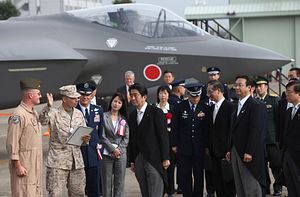The Japanese government has concluded its search efforts for a Japan Air Self-Defense Force (JASDF) fifth-generation Lockheed Martin Lightning II F-35A Joint Strike Fighter that crashed off northern Japan almost two months ago, the country’s minister of defense, Takeshi Iwaya, said today, according to Kyodo News agency.
The report also quotes an unnamed Japanese government source as saying that the JASDF’s fleet of 12 F-35A fighter aircraft will soon resume flight operations. Following the April 9 crash of the F-35A, all JASDF Joint Strike Fighters were grounded. Additionally, pre-delivery flight tests of the 14th F-35A, assembled at the Mitsubishi Heavy Industries (MHI) F-35 Final Assembly and Check Out (FACO) facility in Nagoya, were stopped.
The crashed Joint Strike Fighter was one of four F-35As that took off from Misawa Air Base for a training mission at 6:59 p.m., Japan time, on April 9. The aircraft disappeared from radar tracking systems at 7:27 p.m. about 135 km (84 miles) east of Misawa Air Base, in the northern part of Japan’s main island of Honshu.
The missing F-35A’s tail was found on the ocean’s surface a few hours after the crash; however, the pilot and the aircraft’s fuselage have not been located. A search team recovered parts of the flight data recorder last month. The retrieved part of the flight data recorder was reportedly heavily damaged.
The cause of the crash remains unknown. Japan’s defense minister said on June 4 that the JASDF is analyzing the accident to “narrow down possible causes before long.” He also emphasized that no date has been set for the resumption of F-35A flight operations.
The primary U.S. search effort ended in the third week of April. The U.S. Navy had chartered a privately-owned deep-sea search vessel, the Singapore-operated Van Gogh. This vessel supplemented the search efforts of the Japan Agency for Marine-Earth Science and Technology research vessel Kaimei, equipped with a remote operating vehicle (ROV) that can dive to depths up to 3,000 meters, and the Japan Maritime Self Defense Force (JMSDF) submarine rescue ship JS Chiyoda (ASR-404).
Notably, the commander of U.S. Pacific Air Forces, General Charles Brown, said in April that the crashed F-35A had been located. However, U.S. Forces Japan denied that the fighter jet had been found in a subsequent statement. In April, a senior U.S. Navy official said that U.S. and Japanese search parties were closing in on the F-35A’s fuselage. “We have a pretty good idea where it is,” the official was quoted as saying by CNN on April 24.
While there has been some media speculation that Russia or China will first get to the crash site and recover parts of the aircraft, U.S. and Japanese government officials repeatedly rejected that possibility.
































